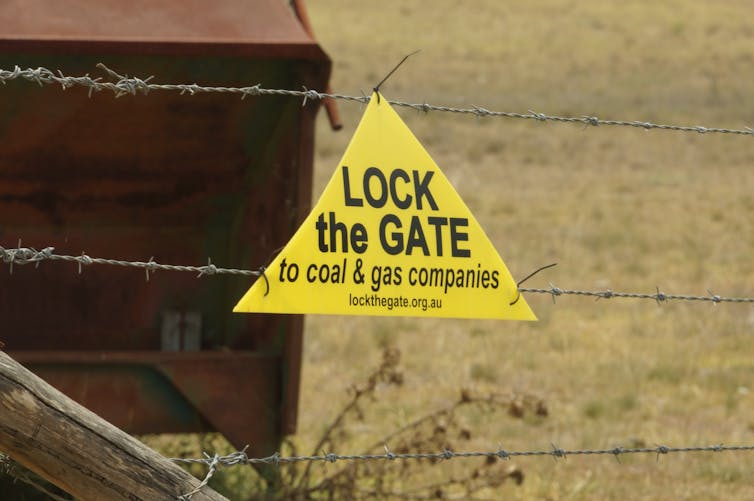Community coal seam gas campaigns have had some big wins lately, most recently in the suspension of the drilling licence for CSG company Metgasco in New South Wales. Referred to the Independent Commission Against Corruption (ICAC), the decision was partly attributed to lack of community consultation.
The suspension follows large protests in March, when nearly 2,000 people turned out to blockade a CSG drill site in the same region.
The success of the campaign is perhaps an aberration, especially considering the failure of many other seemingly identical environmental campaigns, such as those aimed at halting or limiting coastal development and habitat loss through deforestation.
But the fight against CSG along the east coast of Australia is growing, and various community actions have shown further evidence of success.
In the Pilliga Forest, west of Tamworth, the ongoing actions and protests over plans to develop a CSG hub have delayed proceedings dramatically. In November last year, the Victorian government extended a moratorium on fracking until 2015. And in March, the NSW state government backed down on the granting of new CSG licences.
So why are these community campaigns winning, even if it is just in the short term?
A digital campaign
In 1982, a young Bob Brown canoed down a river and kicked off the Save the Franklin campaign, which forced governments around the country to take notice of an increasingly vocal environmental lobby.
The anti-CSG campaign is a demonstration of how different things have become in the world of community protest.

A quick search on Facebook reveals more than 20 eastern Australian anti-CSG sites, including CSG-Rescue NSW, CSG Free Gippsland, Youth Against CSG and Stop CSG Sydney Water Catchment.
A posting on the Bentley protest Facebook site at 4.06pm on Tuesday 6 May read: “Titan rig 3. Headed to Bentley”, revealing the power of social media to provide people with up-to-date information on events of relevance to their protest.
This shows how social media and smart phones are at the heart of the anti-CSG campaign. Facebook, Twitter and Flickr link a vast array of websites, portals, information access points and events.
The campaign is also not just “local” as such, but national and international. Activity in other states, and in places such as the USA have been informing the various Australian campaigns.
Australian efforts to extract coal seam gas affect a large section of the country, and specifically those areas where coal has been mined since the 1830s. This extends from Queensland, through New South Wales and Victoria and on into Tasmania. The campaign is also one of the most professionally run Australia has seen, with a mix of public fundraising, self-financed promotion, public protest events, media reportage, printed information (posters, pamphlets, t-shirts), websites, and organisation through numerous local committees.
The Stop CSG Illawarra campaign and website is a good example of this, with long-time campaigners and community activists involved. In New South Wales the campaign around the area to the south and west of Sydney has, since 2011, proven extremely successful in garnering community support and influencing government decision making. The current activity at Bentley, is a continuation of this.
Because of the growth in social media, groups no longer rely on traditional media such as local newspapers, television and radio to spread their message and mobilise people.

Unusual allies
CSG exploration and extraction effects a wide demographic, ranging from farmers and country folk through to city and non-urban coastal dwellers. People from across the political spectrum have found themselves part of the campaign, whether they be aligned with the conservative right, the radical left or are indifferent.
The Lock the Gate Alliance uses grassroots community engagement to stop unrestrained access to properties from CSG mining companies. The work of the group has opened the eyes of many Australians to the fact that mining rights are separate from property rights – the state owns the mineral wealth of the land, and can therefore grant permission for exploration and mining both below and above ground, regardless of the opposition of the landowner.
In the past this has not been an issue, as large scale coal mining has either existed deep below ground - with little or no impact on landowners - or mining companies have purchased land in and around open cut mining areas, thus eliminating opposition to extraction.
With CSG, the process is different. It is short term – the companies seek permits to explore and then extract for as long as the gas flows. After this the extraction firm and their equipment move on, leaving behind refuse and waste from the process, with extremely worrying claims of contaminated aquifers and water supplies.
This portability of CSG mining is one of its attractions to investors and operators, but it is also one of the reasons the campaign against it has been different to so many other environmental campaigns of recent years.

The NSW Southern Highlands has traditionally been blue ribbon Liberal in its voting patterns at all levels of government. But now we are seeing farmers and large property holders in the area take an active part in the Lock the Gate Alliance. Slogans such as “Australians uniting to protect our land and water”, “Protect our national foodbowl” and “Water not Coal”, reflect the involvement of both city and country constituencies, something not often seen before.
Only time will tell whether these community groups will ultimately be successful. What is obvious though, is that the anti-CSG movement has created a very different type of community campaigning.

